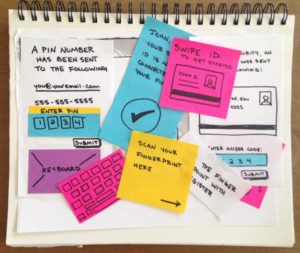Word: Paper Prototyping
Definition: The technique of creating hand-drawn interfaces in order to quickly ideate, simulate, and test early design concepts.
Reference: It's literally as simple as a pencil and paper (and some multi-colored post-it notes if you're feeling very adventurous.) A paper is great for tight budgets, fast iterations, and easy documentation.
Some designers believe that paper is not a reliable testing tool and that users will not take the "arts and crafts" look seriously. I would argue that because there is nothing precious about a paper-prototype and users will be more open and inclined to offer true thoughts and opinions. Look for an example below by yours truly. 😉

Thoughts/Questions: Paper-prototyping is changing with the times and can now be incorporated into more robust applications, such as POP (an app that takes photos of drawings and allows you to link up hot spots to simulate physical clicking and tapping). Do you think prototyping tools like this, which are created to enhance the simplistic and raw experience of paper-prototyping, elevate the gritty research technique or does it adversely affect the underlying nature of it?

No comments.